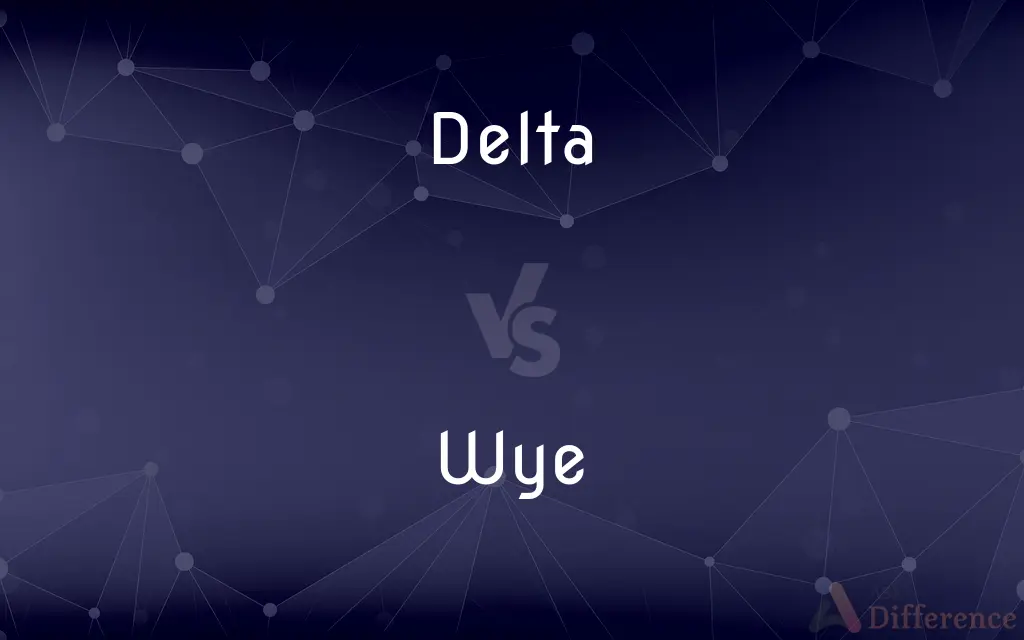Delta vs. Wye — What's the Difference?
By Tayyaba Rehman & Urooj Arif — Updated on March 20, 2024
Delta configurations use a triangular setup for connecting three-phase power circuits, optimizing power handling, whereas Wye configurations use a star setup, offering neutral points for grounding and balanced loads.

Difference Between Delta and Wye
Table of Contents
ADVERTISEMENT
Key Differences
In a Delta configuration, the three phases are connected end-to-end to form a closed loop in a triangular shape. On the other hand, a Wye (or Star) configuration connects all three phases at a common central point, creating a neutral that can be grounded.
Delta configurations are well-suited for high power applications, such as industrial motors and heavy machinery, due to their ability to handle higher power with less material (e.g., thinner conductors for the same power transmission). Conversely, Wye configurations are more commonly used in distribution networks to supply power to residential and commercial buildings, as they allow for the use of a neutral wire for safer grounding and easier load balancing.
The absence of a neutral wire in Delta systems means they inherently lack a ground reference, which can make them less safe in certain applications, such as those requiring direct human interaction. Wye systems, with their neutral grounding, are considered safer for general distribution purposes, as they provide a clear path for fault currents.
Transformers play a crucial role in converting between Delta and Wye configurations to match the power generation method with the distribution or usage needs. For example, a transformer can convert Delta-configured power from a transmission line to a Wye-configured system for local distribution.
Both Delta and Wye configurations have their place in electrical systems, chosen based on the requirements for power distribution, safety, efficiency, and equipment design. Understanding the characteristics of each can help in optimizing power systems for specific applications.
ADVERTISEMENT
Comparison Chart
Configuration Shape
Triangular
Star
Neutral Wire
Absent, no ground reference
Present, allows for grounding
Voltage
Higher phase voltage than line voltage
Line and phase voltages are equal
Applications
High power handling, industrial
Residential and commercial distribution
Safety
Less safe without a neutral for grounding
Safer due to grounding through neutral
Compare with Definitions
Delta
In Delta configurations, the phase voltage is equal to the line voltage times the square root of three.
Delta systems efficiently transmit power over long distances.
Wye
Transforms electrical power for compatibility with different systems.
Wye-Delta transformers are used when connecting to high-power circuits.
Delta
A method of connecting three-phase electrical circuits where phases are connected end-to-end in a triangle.
Delta connections are preferred for certain high-power transformers.
Wye
Includes a neutral for grounding, enhancing safety.
Wye-configured systems are safer for direct consumer use.
Delta
Provides efficient power transmission and high power handling.
Delta-connected systems minimize conductor material for transmission.
Wye
Connects three-phase circuits by joining all three phases at a central point.
Wye configurations are common in residential electrical systems.
Delta
Can be converted to or from Wye configurations using transformers.
A Delta-Wye transformer adapts industrial power for residential use.
Wye
Ideal for distribution networks needing balanced loads.
The Wye connection supports multiple voltage requirements efficiently.
Delta
Suited for heavy machinery and industrial applications.
Delta motors exhibit high starting torque for heavy loads.
Wye
Offers equal line and phase voltages, simplifying load balancing.
Wye systems distribute power evenly to homes and businesses.
Delta
The fourth letter of the Greek alphabet (Δ, δ), transliterated as ‘d’.
Wye
The letter y.
Delta
A code word representing the letter D, used in radio communication.
Wye
An object shaped like a Y.
Delta
A triangular tract of sediment deposited at the mouth of a river, typically where it diverges into several outlets
The Nile delta
A huge delta system developed
Wye
A Y-shaped object: a wye level, wye-connected. Especially a Y-shaped connection of three sections of road or railroad track. Rail transportation
A wye is used to split a single line [hose or cable] into two lines.
By going around the wye, a train can change direction.
Delta
The fourth letter of the Greek alphabet. See Table at alphabet.
Wye
A warrior or fighter.
Delta
An object shaped like a triangle.
Wye
A hero; a man, person.
Delta
A usually triangular alluvial deposit at the mouth of a river.
Wye
(transitive) To make something into a wye (letter Y) shape.
When a hose line is divided into two or more lines, these lines are known as wyed lines.
Delta
A similar deposit at the mouth of a tidal inlet, caused by tidal currents.
Wye
To reverse the direction of a train using a wye.
Since the train didn't have a control cab at the other end, they wyed the train to turn it around for the trip back to the city.
Committee contend that when these trains are wyed at Springfield, the road passenger crews are performing yard work at that point to eliminate switching by yard crews.
Delta
(Mathematics) A finite increment in a variable.
Wye
The letter Y.
Delta
Being in the fourth position relative to a designated carbon atom in an organic molecule at which an atom or a group may be substituted.
Delta
Referring to the fourth of a group of isomers, or molecules of similar origin or properties, determined arbitrarily by those who discover or classify them. Used in combination.
Delta
The fourth letter of the modern Greek alphabet Δ, δ.
Delta
A landform at the mouth of a river where it empties into a body of water.
Delta
(international standards) nodot=1 NATO/ICAO Phonetic Alphabet.}}
Delta
(mathematics) The symbol Δ.
Delta
A small but noticeable effect. Compare epsilon.
This will slow the main code path down, but only by delta.
Delta
(computing) The set of differences between two versions of a file.
When you update the file, the system will only save the deltas.
Delta
A change in a quantity, likely from "d" for "difference".
ΔV - "delta vee"(change in velocity, used in rocketry and orbital mechanics)
Delta
(surveying) The angle subtended at the center of a circular arc.
Delta
A type of cargo bike that has one wheel in front and two in back.
Delta
The closed figure produced by connecting three coils or circuits successively, end for end, especially in a three-phase system.
Delta winding; delta connection; delta current
Delta
(finance) The rate of change in an option value with respect to the underlying asset's price.
Delta
(chemistry) A value in delta notation indicating the relative abundances of isotopes.
Delta
A military unit, nominally headed by a colonel, equivalent to a USAF operations wing, or an army regiment.
Delta
(astronomy) a star that is usually the fourth brightest of a constellation.
Delta
(physics) one of four baryons consisting of up and down quarks with a combined spin of 3/2: Δ++ (uuu), Δ+ (uud), Δ0 (udd), or Δ− (ddd)
Delta
(medicine) delta variant variant of the SARS-CoV-2 virus
Delta
(cryptography) To calculate the differences between the characters in an enciphered text and the characters a fixed number of positions previous.
Delta
(computing) To compare two versions of the same file in order to determine where they differ (where a programmer has made edits).
Delta
The fourth letter of the Greek alphabet (
Delta
A tract of land shaped like the letter delta (
Delta
The closed figure produced by connecting three coils or circuits successively, end for end, esp. in a three-phase system; - often used attributively, as delta winding, delta connection (which see), etc.
Delta
A low triangular area where a river divides before entering a larger body of water
Delta
The 4th letter of the Greek alphabet
Common Curiosities
Can Delta and Wye configurations coexist in the same power system?
Yes, they can coexist. Transformers are often used to convert power from Delta to Wye or vice versa, depending on the application's requirements.
How does the presence of a neutral wire in a Wye configuration enhance safety?
The neutral wire provides a path for fault currents to the ground, reducing the risk of electric shock and equipment damage, making Wye configurations safer for general use.
What is the main difference between Delta and Wye configurations?
The main difference lies in their connections: Delta forms a triangle without a neutral point, while Wye connects all phases at a central point with a neutral for grounding.
Why is there no neutral in Delta configurations?
Delta configurations connect the phases in a loop, eliminating the need for a neutral point, which is primarily used for grounding and balancing loads in Wye configurations.
Which configuration is better for long-distance power transmission?
Delta configurations are often preferred for long-distance power transmission due to their efficient use of conductors and higher power handling capabilities.
Can you convert between Delta and Wye configurations?
Yes, conversion between Delta and Wye is common and achieved through the use of transformers, allowing the adaptation of power systems to meet different requirements.
What applications are best suited for Delta configurations?
Delta configurations are best suited for applications requiring high power handling, such as industrial machinery and high-power motors.
Why are Wye configurations commonly used in residential areas?
Wye configurations provide a neutral for grounding and facilitate easier load balancing, making them safer and more suitable for residential and commercial distribution.
How does the absence of a neutral wire affect Delta configurations?
Without a neutral wire, Delta configurations lack a direct ground path, which can pose safety risks and make them less suitable for applications requiring grounding.
What are the benefits of having a neutral wire in electrical systems?
A neutral wire provides a path for current in unbalanced loads, enables grounding for safety, and facilitates easier distribution of power across phases.
Can the use of a Delta configuration reduce the need for conductive material?
Yes, Delta configurations can reduce the need for conductive material by allowing higher power transmission with thinner conductors, due to the higher phase voltage.
Is it more expensive to implement a Delta or a Wye configuration?
The cost depends on the application; Delta might be more cost-effective for high-power applications due to less material use, while Wye might be preferred for safety and load balancing in residential settings.
How do transformers adapt power from Delta to Wye configurations?
Transformers can change the connection pattern of the windings, effectively converting Delta-configured power to a Wye configuration to meet the needs of different electrical systems.
Which configuration offers better system stability, Delta or Wye?
Wye configurations often offer better stability for distributing power to balanced loads, especially in residential and commercial settings, due to the grounding and neutral wire.
Share Your Discovery

Previous Comparison
Autumn vs. Spring
Next Comparison
Leisure vs. EntertainmentAuthor Spotlight
Written by
Tayyaba RehmanTayyaba Rehman is a distinguished writer, currently serving as a primary contributor to askdifference.com. As a researcher in semantics and etymology, Tayyaba's passion for the complexity of languages and their distinctions has found a perfect home on the platform. Tayyaba delves into the intricacies of language, distinguishing between commonly confused words and phrases, thereby providing clarity for readers worldwide.
Co-written by
Urooj ArifUrooj is a skilled content writer at Ask Difference, known for her exceptional ability to simplify complex topics into engaging and informative content. With a passion for research and a flair for clear, concise writing, she consistently delivers articles that resonate with our diverse audience.














































